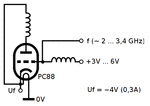neazoi
Advanced Member level 6
Hi, I have build this oscillator with success.
https://upload.wikimedia.org/wikipedia/commons/5/52/Barkhausen_Kurz_PC88.svg
However I dissasembled the circuit.
I was wondering what will happen if I make Uf=0V and the cathode and anode negative?
1. Will the vrequency be increased?
2. Will the amplitude be increased?
https://upload.wikimedia.org/wikipedia/commons/5/52/Barkhausen_Kurz_PC88.svg
However I dissasembled the circuit.
I was wondering what will happen if I make Uf=0V and the cathode and anode negative?
1. Will the vrequency be increased?
2. Will the amplitude be increased?
